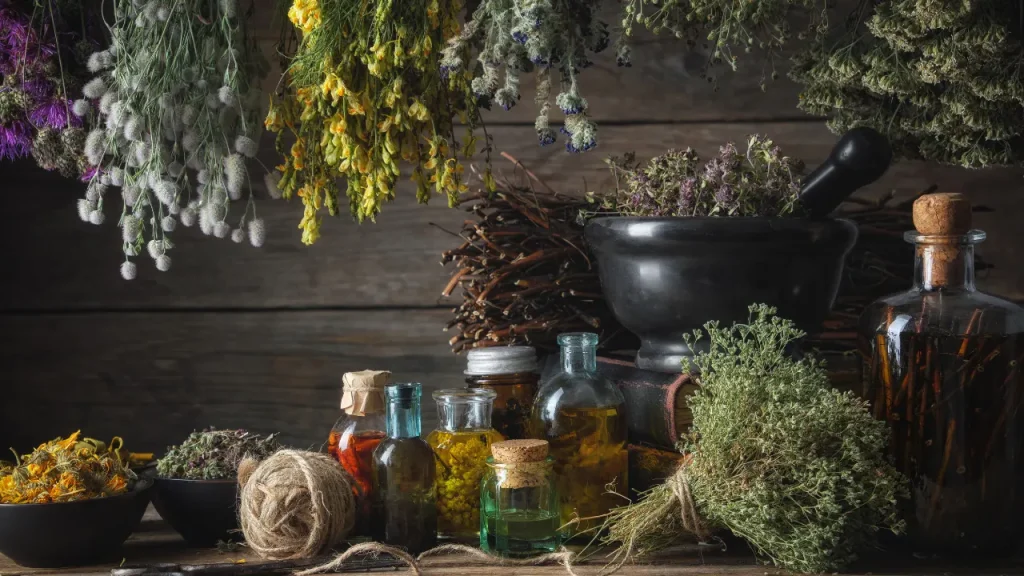Humans have looked for natural cures throughout history to enhance health and well-being. Butcher’s Broom (Ruscus aculeatus), a perennial evergreen shrub endemic to Mediterranean climates, is one such botanical marvel. The therapeutic benefits of butcher’s broom, also known as knee holly or sweet broom, have been utilized for ages. Due to its possible health advantages, it has attracted interest as a dietary supplement recently. This page seeks to provide a thorough review of Butcher’s Broom, including its characteristics, health advantages, recommended dose, negative effects, possible drug interactions, and appropriate usage.
You May Also Like:
Nature’s Secret for Mental Alertness: Green Coffee Beans
Keep Your Brain Young With the 5 Most Powerful Nootropic Supplements
Butcher’s Broom: Benefits, Dosage, Side Effects, Drug Interactions, and Other Important Information is an original (NootropicsPlanet) article.
Nature of Butcher’s Broom
The Asparagaceae family plant known as butcher’s broom is distinguished by its spiky, leaf-like stalks and vivid crimson berries. The rhizomes of the plant that grow underground, which contain bioactive substances, are mostly employed for medical reasons. These bioactive substances, which support its medicinal activities, include steroidal saponins, flavonoids, phenolic acids, and ruscogenins.
Health Benefits of Butcher’s Broom
A variety of possible health advantages of butcher’s broom have been documented. Healthy circulation is one of its most noteworthy applications. According to research, Butcher’s Broom’s active ingredients increase venous tone, decrease capillary permeability, and induce vasoconstriction. For ailments including chronic venous insufficiency, varicose veins, and hemorrhoids, this makes it especially advantageous.
Butcher’s Broom also has diuretic qualities that help to relieve minor edema and water retention. Additionally, it could contain anti-inflammatory properties that lessen inflammation which effectively reduces the symptoms brought on by illnesses like arthritis.

Chemistry of Butcher’s Broom:
Unraveling its Bioactive Compounds
The chemistry of butcher’s broom is a fascinating topic that explains the therapeutic benefits of the plant. Butcher’s Broom has a number of bioactive substances that support its medicinal benefits. Let’s examine this unique botanical’s main chemical components.
- Steroidal Saponins: Butcher’s Broom includes a variety of steroidal saponins, which are glycosides attached to one or more sugar molecules by a steroid or triterpenoid aglycone. Butcher’s broom has a high concentration of ruscogenins, a class of steroidal saponins thought to be responsible for many of the herb’s pharmacological effects. The medicinal potential of the plant is enhanced by the anti-inflammatory, vasoconstrictive, and diuretic properties of these substances.
- Flavonoids: Flavonoids are a broad category of secondary metabolites found in plants that are prized for their anti-inflammatory and antioxidant activities. Flavonoids including rutin, kaempferol, and quercetin are present in butcher’s broom. These substances have been linked to a number of health advantages, such as enhancing vascular health, lowering oxidative stress, and controlling immunological responses.
- Phenolic Acids: Other phenolic acids found in butcher’s broom are ferulic acid and caffeic acid. These substances support the plant’s general bioactivity and have anti-inflammatory and antioxidant capabilities.
- Additional Constituents: Coumarins, triterpenes, and glycolipids are just a few of the additional substances found in butcher’s broom. They probably contribute to the plant’s overall pharmacological profile even if their precise functions and methods of action are not yet completely known.
Physiological Mechanism of Action of Butcher’s Broom
The bioactive components in butcher’s broom and their physiological effects on the body are responsible for its health advantages. Alpha-adrenergic receptor activation, which results in vasoconstriction and elevated venous tone, is the main mechanism of action. This aids in enhancing blood flow and easing the signs and symptoms of circulatory diseases.
Because of its impact on renal tubular cells and electrolyte transport systems, butcher’s broom also has diuretic effects. It promotes kidney function and aids in the removal of extra fluid by boosting urine output.
Additionally, it is believed that Butcher’s Broom’s anti-inflammatory qualities are mediated via the suppression of pro-inflammatory enzymes and cytokines, which may help lessen pain and inflammation related to certain illnesses.

Optimal Dosage of Butcher’s Broom
Due to differences in product formulas and individual responses, figuring out the best Butcher’s Broom dose may be difficult. It is crucial to adhere to the manufacturer’s instructions or seek advice from a healthcare provider. A common dose of butcher’s broom extract, standardized to contain 9-11% ruscogenins, is 150 to 300 mg administered orally once or twice a day. Individual demands, however, might differ, so it’s best to start with a smaller dose and gradually raise it as necessary.
Side Effects of Butcher’s Broom
When taken as prescribed, butcher’s broom is usually regarded as harmless, however, some people may have minor adverse effects. Gastrointestinal discomfort, such as upset stomach, nausea, or diarrhea, might be one of them. It’s important to pay attention to how your body reacts and stop using if any negative side effects appear. Women who are expecting or nursing, as well as anybody with a history of hypertension or certain medical disorders, should use caution and speak with a doctor before taking Butcher’s Broom.

Potential Substance Interactions with Butcher’s Broom
It is crucial to be aware of possible interactions with drugs or other substances while using any supplement. Some medicines, such as blood thinners, antiplatelet drugs, and medications for hypertension may interact with butcher’s broom. This is because it could impact blood pressure and blood coagulation. Before using Butcher’s Broom, it is advised to speak with a healthcare provider if you are currently taking any drugs or have any underlying medical concerns.
Responsible Use of Butcher’s Broom
It’s crucial to use Butcher’s Broom properly while using it as a dietary supplement. Here are some important things to think about:
- Source and Quality: Be careful to get Butcher’s Broom from reputed suppliers that follow proper production procedures and provide standardized extracts with consistent strength.
- Dosage and Use: To establish the right dosage for your unique requirements, refer to the manufacturer’s dosage recommendations or seek advice from a healthcare provider. Unless directed otherwise by a healthcare provider, do not take more than the suggested dosage.
- Observation and monitoring when taking Butcher’s Broom, pay attention to how your body reacts. Stop using it right away and seek medical advice if you suffer any side effects.
- Medical Conditions and Medicines: It’s crucial to speak with a doctor before using Butcher’s Broom if you have any underlying medical issues or are on any medicines, especially anticoagulants, antiplatelet medications, or hypertension medications.
Butcher’s Broom:
Conclusion
Butcher’s Broom (Ruscus aculeatus) emerges as a resilient perennial evergreen shrub native to Mediterranean climates, often known for its historical use in traditional medicine. This unique plant has characteristic tough, spiky leaves with bright red berries. Butcher’s broom carries potential benefits related to circulatory health. It contains active ingredients such as saponins, flavonoids, and phenolic acids which contribute to the plant’s anti-inflammatory, diuretic, and vasoconstrictive effects. Butcher’s Broom is a good natural remedy, however, you should always consult healthcare professionals and approach its use responsibly. As we delve into the world of herbal remedies, it’s essential to balance our curiosity with informed choices, ensuring our well-being while harnessing the potential benefits of such plants.

References:
- Efficacy and Safety of A Butcher’s Broom Preparation (Ruscus Aculeatus L. Extract) Compared to Placebo in Patients Suffering from Chronic Venous Insufficiency. Retrieved from: https://pubmed.ncbi.nlm.nih.gov/12040966/
- Ruscus Aculeatus (Butcher’s Broom) as A Potential Treatment for Orthostatic Hypotension, with A Case Report. Retrieved from: https://pubmed.ncbi.nlm.nih.gov/11152059/
- Ruscus Aculeatus (Butcher’s Broom). Monograph. Retrieved from: https://pubmed.ncbi.nlm.nih.gov/11804550/
Important Note: The information contained in this article is for general informational purposes only, and should not be construed as health or medical advice, nor is it intended to diagnose, prevent, treat, or cure any disease or health condition. Before embarking on any diet, fitness regimen, or program of nutritional supplementation, it is advisable to consult your healthcare professional in order to determine its safety and probable efficacy in terms of your individual state of health.
Regarding Nutritional Supplements Or Other Non-Prescription Health Products: If any nutritional supplements or other non-prescription health products are mentioned in the foregoing article, any claims or statements made about them have not been evaluated by the U.S. Food and Drug Administration, and such nutritional supplements or other health products are not intended to diagnose, treat, cure, or prevent any disease.


